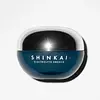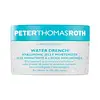What's inside
What's inside
 Key Ingredients
Key Ingredients

 Benefits
Benefits

 Concerns
Concerns

 Ingredients Side-by-side
Ingredients Side-by-side

Maris Aqua
HumectantWater
Skin ConditioningButylene Glycol
HumectantGlycerin
HumectantSqualane
EmollientSaccharomyces/Xylinum/Black Tea Ferment
Skin ConditioningMethyl Gluceth-20
HumectantPentylene Glycol
Skin ConditioningAcrylates/C10-30 Alkyl Acrylate Crosspolymer
Emulsion StabilisingSaccharide Isomerate
HumectantPolyglycerin-3
HumectantPhytosteryl/Octyldodecyl Lauroyl Glutamate
Skin ConditioningXylitol
HumectantBetaine
HumectantSodium Hydroxide
BufferingParfum
MaskingHydroxyethylcellulose
Emulsion StabilisingDisodium EDTA
Dipotassium Glycyrrhizate
HumectantEthylhexylglycerin
Skin ConditioningZinc Gluconate
Skin ConditioningMagnesium Aspartate
Skin ConditioningPhenoxyethanol
PreservativeSodium Citrate
BufferingUndaria Pinnatifida Extract
Skin ConditioningCitric Acid
BufferingTocopherol
AntioxidantAlpha-Isomethyl Ionone
PerfumingChlorella Vulgaris Extract
Skin ConditioningCopper Gluconate
Skin ConditioningBenzyl Salicylate
PerfumingPotassium Sorbate
PreservativeTetradecyl Aminobutyroylvalylaminobutyric Urea Trifluoroacetate
Skin ConditioningGeraniol
PerfumingLimonene
PerfumingMagnesium Chloride
Biotin
AntiseborrhoeicMaris Aqua, Water, Butylene Glycol, Glycerin, Squalane, Saccharomyces/Xylinum/Black Tea Ferment, Methyl Gluceth-20, Pentylene Glycol, Acrylates/C10-30 Alkyl Acrylate Crosspolymer, Saccharide Isomerate, Polyglycerin-3, Phytosteryl/Octyldodecyl Lauroyl Glutamate, Xylitol, Betaine, Sodium Hydroxide, Parfum, Hydroxyethylcellulose, Disodium EDTA, Dipotassium Glycyrrhizate, Ethylhexylglycerin, Zinc Gluconate, Magnesium Aspartate, Phenoxyethanol, Sodium Citrate, Undaria Pinnatifida Extract, Citric Acid, Tocopherol, Alpha-Isomethyl Ionone, Chlorella Vulgaris Extract, Copper Gluconate, Benzyl Salicylate, Potassium Sorbate, Tetradecyl Aminobutyroylvalylaminobutyric Urea Trifluoroacetate, Geraniol, Limonene, Magnesium Chloride, Biotin
Water
Skin ConditioningGlycereth-26
HumectantCitrus Aurantium Bergamia Fruit Water
Skin ConditioningMethylpropanediol
SolventGlycerin
HumectantSodium Hyaluronate
HumectantAmylopectin
Lithothamnion Calcareum Extract
Skin ConditioningAloe Barbadensis Leaf Juice
Skin ConditioningLactic Acid
BufferingPanthenol
Skin ConditioningCitric Acid
BufferingXanthan Gum
EmulsifyingCarbomer
Emulsion StabilisingSodium Phytate
Potassium Sorbate
PreservativeSodium Benzoate
MaskingHydroxyethylcellulose
Emulsion StabilisingMethylglucamine
Pentylene Glycol
Skin ConditioningEthylhexylglycerin
Skin ConditioningSodium Acryloyldimethyltaurate/Vp Crosspolymer
Emulsion StabilisingT-Butyl Alcohol
PerfumingPhenoxyethanol
PreservativeWater, Glycereth-26, Citrus Aurantium Bergamia Fruit Water, Methylpropanediol, Glycerin, Sodium Hyaluronate, Amylopectin, Lithothamnion Calcareum Extract, Aloe Barbadensis Leaf Juice, Lactic Acid, Panthenol, Citric Acid, Xanthan Gum, Carbomer, Sodium Phytate, Potassium Sorbate, Sodium Benzoate, Hydroxyethylcellulose, Methylglucamine, Pentylene Glycol, Ethylhexylglycerin, Sodium Acryloyldimethyltaurate/Vp Crosspolymer, T-Butyl Alcohol, Phenoxyethanol
Ingredients Explained
These ingredients are found in both products.
Ingredients higher up in an ingredient list are typically present in a larger amount.
Citric Acid is an alpha hydroxy acid (AHA) naturally found in citrus fruits like oranges, lemons, and limes.
Like other AHAs, citric acid can exfoliate skin by breaking down the bonds that hold dead skin cells together. This helps reveal smoother and brighter skin underneath.
However, this exfoliating effect only happens at high concentrations (20%) which can be hard to find in cosmetic products.
Due to this, citric acid is usually included in small amounts as a pH adjuster. This helps keep products slightly more acidic and compatible with skin's natural pH.
In skincare formulas, citric acid can:
While it can provide some skin benefits, research shows lactic acid and glycolic acid are generally more effective and less irritating exfoliants.
Most citric acid used in skincare today is made by fermenting sugars (usually from molasses). This synthetic version is identical to the natural citrus form but easier to stabilize and use in formulations.
Read more about some other popular AHA's here:
Learn more about Citric AcidEthylhexylglycerin (we can't pronounce this either) is commonly used as a preservative and skin softener. It is derived from glyceryl.
You might see Ethylhexylglycerin often paired with other preservatives such as phenoxyethanol. Ethylhexylglycerin has been found to increase the effectiveness of these other preservatives.
Glycerin is already naturally found in your skin. It helps moisturize and protect your skin.
A study from 2016 found glycerin to be more effective as a humectant than AHAs and hyaluronic acid.
As a humectant, it helps the skin stay hydrated by pulling moisture to your skin. The low molecular weight of glycerin allows it to pull moisture into the deeper layers of your skin.
Hydrated skin improves your skin barrier; Your skin barrier helps protect against irritants and bacteria.
Glycerin has also been found to have antimicrobial and antiviral properties. Due to these properties, glycerin is often used in wound and burn treatments.
In cosmetics, glycerin is usually derived from plants such as soybean or palm. However, it can also be sourced from animals, such as tallow or animal fat.
This ingredient is organic, colorless, odorless, and non-toxic.
Glycerin is the name for this ingredient in American English. British English uses Glycerol/Glycerine.
Learn more about GlycerinHydroxyethylcellulose is used to improve the texture of products. It is created from a chemical reaction involving ethylene oxide and alkali-cellulose. Cellulose is a sugar found in plant cell walls and help give plants structure.
This ingredient helps stabilize products by preventing ingredients from separating. It can also help thicken the texture of a product.
This ingredient can also be found in pill medicines to help our bodies digest other ingredients.
Learn more about HydroxyethylcellulosePentylene glycol is typically used within a product to thicken it. It also adds a smooth, soft, and moisturizing feel to the product. It is naturally found in plants such as sugar beets.
The hydrophilic trait of Pentylene Glycol makes it a humectant. As a humectant, Pentylene Glycol helps draw moisture from the air to your skin. This can help keep your skin hydrated.
This property also makes Pentylene Glycol a great texture enhancer. It can also help thicken or stabilize a product.
Pentylene Glycol also acts as a mild preservative and helps to keep a product microbe-free.
Some people may experience mild eye and skin irritation from Pentylene Glycol. We always recommend speaking with a professional about using this ingredient in your routine.
Pentylene Glycol has a low molecular weight and is part of the 1,2-glycol family.
Learn more about Pentylene GlycolPhenoxyethanol is a preservative that has germicide, antimicrobial, and aromatic properties. Studies show that phenoxyethanol can prevent microbial growth. By itself, it has a scent that is similar to that of a rose.
It's often used in formulations along with Caprylyl Glycol to preserve the shelf life of products.
Potassium Sorbate is a preservative used to prevent yeast and mold in products. It is commonly found in both cosmetic and food products.
This ingredient comes from potassium salt derived from sorbic acid. Sorbic acid is a natural antibiotic and effective against fungus.
Both potassium sorbate and sorbic acid can be found in baked goods, cheeses, dried meats, dried fruit, ice cream, pickles, wine, yogurt, and more.
You'll often find this ingredient used with other preservatives.
Learn more about Potassium SorbateWater. It's the most common cosmetic ingredient of all. You'll usually see it at the top of ingredient lists, meaning that it makes up the largest part of the product.
So why is it so popular? Water most often acts as a solvent - this means that it helps dissolve other ingredients into the formulation.
You'll also recognize water as that liquid we all need to stay alive. If you see this, drink a glass of water. Stay hydrated!
Learn more about Water